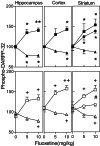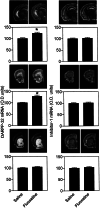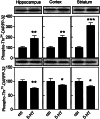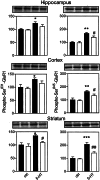Involvement of striatal and extrastriatal DARPP-32 in biochemical and behavioral effects of fluoxetine (Prozac)
- PMID: 11880651
- PMCID: PMC122493
- DOI: 10.1073/pnas.052712799
Involvement of striatal and extrastriatal DARPP-32 in biochemical and behavioral effects of fluoxetine (Prozac)
Abstract
Fluoxetine (Prozac) is the most widely prescribed medication for the treatment of depression. Nevertheless, little is known about the molecular basis of its clinical efficacy, apart from the fact that fluoxetine increases the synaptic availability of serotonin. Here we show that, in vivo, fluoxetine, given either acutely or chronically, regulates the phosphorylation state of dopamine- and cAMP-regulated phosphoprotein of M(r) 32,000 (DARPP-32) at multiple sites in prefrontal cortex, hippocampus, and striatum. Acute administration of fluoxetine increases phosphorylation of DARPP-32 at the protein kinase A site, Thr-34, and at the casein kinase-1 site, Ser-137, and decreases phosphorylation at the cyclin-dependent kinase 5 site, Thr-75. Each of these changes contributes, through distinct signaling pathways, to increased inhibition of protein phosphatase-1, a major serine/threonine protein phosphatase in the brain. Fluoxetine also increases phosphorylation of the alpha-amino-3-hydroxy-5-methyl-4-isoxazolepropionic acid (AMPA) receptor subunit GluR1 at Ser-831 and Ser-845. Both the fluoxetine-mediated increase in AMPA receptor phosphorylation at Ser-845-GluR1 and the beneficial responsiveness to fluoxetine in an animal test of antidepressant efficacy were strongly reduced in DARPP-32 knockout mice, indicating a critical role for this phosphoprotein in the antidepressant actions of fluoxetine. Mice chronically treated with fluoxetine had increased levels of DARPP-32 mRNA and protein and a decreased ability to increase phospho-Ser-137-DARPP-32 and phospho-Ser-831-GluR1. These chronic changes may be relevant to the delayed onset of therapeutic efficacy of fluoxetine.
Figures






References
-
- Duman R S, Heninger G R, Nestler E J. Arch Gen Psychiatry. 1997;54:597–606. - PubMed
-
- Manji H K, Drevets W C, Charney D S. Nat Med. 2001;7:541–547. - PubMed
-
- Horowski R, Sastre-Y-Hernandez M. Curr Ther Res. 1985;38:23–29.
-
- Fleischhacker W W, Hinterhuber H, Bauer H, Pflug B, Berner P, Simhandl C, Wilf R, Gerlach W, Jaklitsch H, Sastre-Y-Hernandez M, et al. Neuropsychobiology. 1992;26:59–64. - PubMed
-
- Walaas S I, Aswad D W, Greengard P. Nature (London) 1983;301:69–71. - PubMed
Publication types
MeSH terms
Substances
Grants and funding
LinkOut - more resources
Full Text Sources
Other Literature Sources
Medical
Molecular Biology Databases

